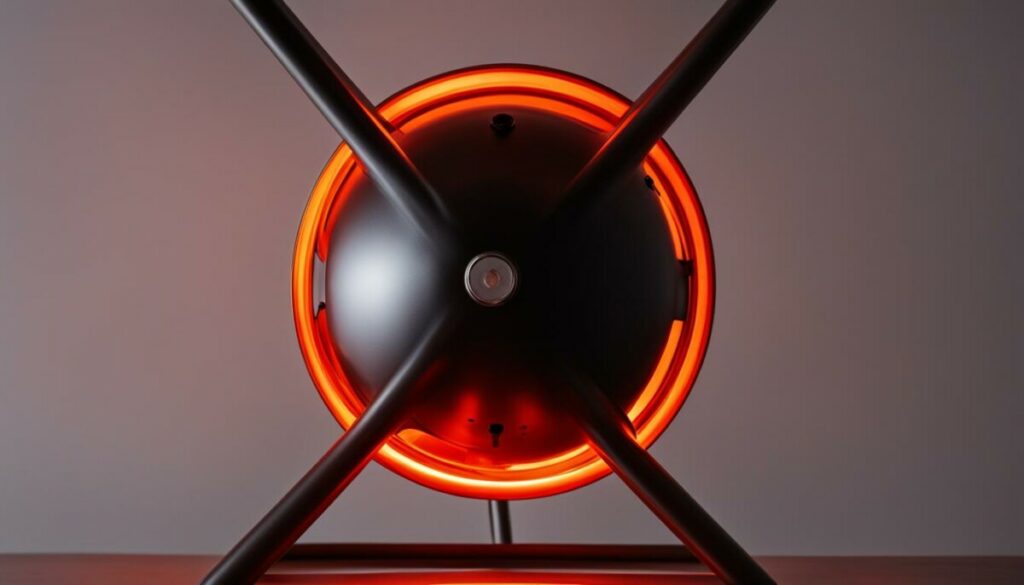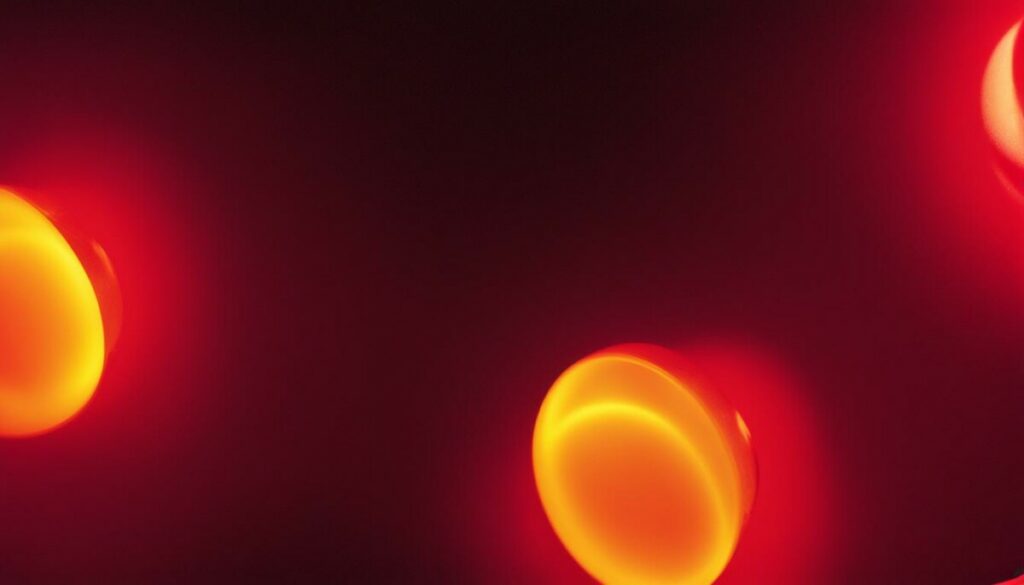Last Updated on 5 months by Francis
Heat lamps and infrared lamps have been a popular topic of discussion when it comes to their heating capabilities. The question that arises is whether heat lamps are actually infrared lamps. To answer this, we need to understand the concept of radiation and light.
Radiation is often associated with nuclear radiation, but it actually refers to any kind of light, including visible light. Infrared radiation falls within the broad spectrum of light and is a form of radiation that is emitted by objects that radiate heat. Heat lamps, therefore, fall under the category of infrared lamps as they emit infrared radiation to provide heat.
Understanding the connection between heat lamps and infrared radiation is essential to grasp their functionality and benefits in various applications.
Contents
Key Takeaways:
- Heat lamps are a type of infrared lamp as they emit infrared radiation to provide heat.
- Infrared radiation falls within the broad spectrum of light and is a form of radiation that is emitted by objects that radiate heat.
- Heat lamps offer various therapeutic benefits and are commonly used in physical therapy, muscle pain relief, and relaxation.
- Understanding the science behind infrared heat lamps and following safety precautions is essential for their effective and safe use.
- The future of infrared heat lamps holds exciting possibilities in various fields, with ongoing research exploring new applications and benefits.
The Science Behind Infrared Heat Lamps

Infrared heat lamps operate on the fundamental principle of emitting infrared radiation, which is a form of electromagnetic radiation. Unlike traditional heat sources that warm the surrounding air, infrared heat lamps emit heat directly in the form of infrared radiation. This radiation has the ability to penetrate the skin and be absorbed by the body, offering therapeutic benefits. Infrared heat lamps are widely used in various applications such as physical therapy, muscle pain relief, relaxation, and even in cosmetic treatments like skin rejuvenation.
The deep penetration of infrared radiation makes it an effective heating method for targeted therapy and maximum benefits. This is why infrared heat lamps are commonly used in the field of physical therapy and pain management. The ability to directly emit heat and penetrate the body allows for focused and precise treatment of various conditions such as arthritis, muscle strains, and chronic pain. Additionally, the use of infrared heat lamps can improve blood circulation, promote detoxification, reduce inflammation, and even boost the immune system.
As technology advances and research in the field of infrared radiation continues, the future of infrared heat lamps holds promise for further advancements and applications. Ongoing studies are exploring new therapeutic uses of infrared heat therapy, such as improved wound healing, pain management for chronic conditions, and even potential uses in cancer treatment. With their effectiveness and versatility, infrared heat lamps are expected to play a significant role in enhancing well-being and providing efficient heating solutions in various industries.
Benefits of Infrared Heat Lamps
Infrared heat lamps offer a wide range of benefits, making them a popular choice for pain relief and relaxation. One of the key advantages of infrared heat lamps is their ability to penetrate deep into the body, providing targeted heat therapy. This deep penetration helps alleviate various conditions such as arthritis, muscle strains, and chronic pain. Unlike traditional heat sources that primarily heat the surrounding air, infrared heat lamps directly emit heat in the form of infrared radiation. This targeted approach allows for more effective pain relief and faster recovery.
Additionally, the use of infrared heat lamps can improve blood circulation, promoting faster healing and reducing inflammation. The deep heat provided by infrared radiation helps to increase blood flow to the treated area, delivering oxygen and nutrients to the tissues. This increased circulation not only aids in pain relief but also promotes the body’s natural healing process. Infrared heat lamps have also been found to aid in detoxification and boost the immune system, further enhancing their therapeutic benefits.
Moreover, the versatility of infrared heat lamps extends beyond pain relief. They are widely used in physical therapy clinics, spas, and wellness centers for relaxation and rejuvenation purposes. Infrared heat can stimulate collagen production, resulting in improved skin elasticity and reduced signs of aging. It can also help with conditions such as acne and eczema by reducing inflammation and promoting cell regeneration. The wide range of applications and numerous benefits make infrared heat lamps a valuable tool in promoting overall well-being.
| Benefits | Benefits of Infrared Heat Lamps |
|---|---|
| Pain Relief | Infrared heat lamps penetrate deep into the body, providing targeted pain relief for conditions such as arthritis and muscle strains. |
| Blood Circulation | Infrared heat lamps improve blood circulation, promoting faster healing and reducing inflammation. |
| Detoxification | These lamps aid in detoxification by increasing blood flow and promoting the elimination of toxins from the body. |
| Immune System | Infrared heat lamps can help boost the immune system, improving overall health and well-being. |
| Relaxation and Rejuvenation | Infrared heat lamps are commonly used in spas and wellness centers for relaxation and rejuvenation purposes, promoting healthier skin and reducing signs of aging. |
In summary, the benefits of infrared heat lamps are vast and diverse. They provide targeted pain relief, improve blood circulation, aid in detoxification, boost the immune system, and promote relaxation and rejuvenation. Whether used for therapeutic purposes or enhancing overall well-being, infrared heat lamps are a valuable tool in achieving optimum health. It is important to follow safety precautions and consult with a healthcare professional before starting any infrared heat lamp therapy to ensure safe and effective use.
How Do Infrared Heat Lamps Work?

Infrared heat lamps work by emitting infrared radiation, which is absorbed by the body and converted into heat. These lamps consist of a special type of bulb that produces infrared radiation when electricity passes through it. The emitted radiation is then directed towards the desired area or body part.
It is important to note that safety precautions should be taken when using infrared heat lamps. Due to their ability to generate intense heat, it is advisable to follow the manufacturer’s instructions, maintain a safe distance from the lamp, and avoid prolonged exposure to prevent potential burns or skin damage.
Understanding the Mechanism
“Infrared heat lamps emit infrared radiation, which is a form of electromagnetic radiation. These lamps transform electrical energy into heat energy, which is then absorbed by the body.”
The mechanism behind infrared heat lamps is based on the conversion of electrical energy into heat energy. The specific design of the lamp’s bulb allows it to produce infrared radiation, which falls within the electromagnetic spectrum. When the lamp is turned on, electrical energy passes through the bulb, causing its filament to heat up. As a result, the filament emits infrared radiation, which is then directed towards the desired area.
Safety Precautions
“To ensure safe use, it is important to follow safety precautions when using infrared heat lamps. These precautions include maintaining a safe distance from the lamp, avoiding prolonged exposure, and following the manufacturer’s instructions.”
When using infrared heat lamps, it is crucial to prioritize safety. To prevent potential burns or skin damage, it is recommended to maintain a safe distance from the lamp, typically indicated in the manufacturer’s instructions. Avoiding prolonged exposure to the lamp’s heat is also important to minimize any risks. By adhering to these safety precautions, users can safely benefit from the therapeutic properties of infrared heat lamps.
Applications of Infrared Heat Lamps

Whether in the medical field, beauty and wellness industry, or industrial settings, infrared heat lamps have a wide range of applications. The unique heating properties of these lamps make them a valuable tool in various professional settings.
Medical Field
Infrared heat lamps play a crucial role in the medical field, particularly in physical therapy clinics, hospitals, and sports medicine. These lamps are used for targeted heat therapy, helping with muscle pain relief, injury recovery, and rehabilitation. The deep penetration of infrared radiation ensures maximum therapeutic benefits for patients. They are also effective in conditions such as arthritis, muscle strains, and chronic pain.
Beauty and Wellness
In the beauty and wellness industry, infrared heat lamps are widely utilized for various skin treatments. These lamps stimulate collagen production, reducing the appearance of wrinkles and fine lines. They also help in acne reduction and skin rejuvenation. Infrared heat lamps provide a non-invasive and efficient method for improving the overall health and appearance of the skin.
Industrial Settings
Infrared heat lamps are employed in industrial settings for processes such as drying, curing, and heating. They are used in manufacturing and production for efficient and precise heating of materials. Infrared radiation allows for faster and more targeted heating, optimizing production processes and reducing energy consumption.
| Industry | Applications |
|---|---|
| Medical | Physical therapy, pain management, rehabilitation |
| Beauty and Wellness | Skin rejuvenation, wrinkle reduction, acne reduction |
| Industrial | Drying, curing, heating in manufacturing and production |
These are just a few examples of the many applications of infrared heat lamps. The versatility and efficiency of these lamps make them an invaluable tool in providing targeted heat therapy, improving skin health, and optimizing industrial processes.
Choosing the Best Infrared Heat Lamp
When it comes to choosing the best infrared heat lamp, several factors should be considered to ensure maximum effectiveness and safety. One crucial aspect is the power output of the lamp, which determines the intensity of the heat emitted. Higher power output lamps generally provide more intense heat, while lower power output lamps offer a gentler heat experience. The power output should be selected based on the specific therapy or application goals.
An important consideration is the wavelength range of the infrared heat lamp. Different wavelengths penetrate the body to varying depths, influencing the therapeutic benefits. Shorter wavelengths have a more superficial penetration, making them suitable for skin treatments, while longer wavelengths can penetrate deeper to target muscles and joints. Adjustable wavelength settings in the lamp allow customization based on individual needs and preferences.
Adjustable settings such as temperature control and timer functions are valuable features to look for in an infrared heat lamp. Temperature control allows for precise heat adjustments, while timers ensure safe usage by automatically shutting off the lamp after a specified duration. These features offer convenience and enhance the overall user experience.
When selecting an infrared heat lamp, it is recommended to choose a reputable brand that meets safety standards. Reading product reviews and consulting with professionals can provide valuable insights and help in making an informed decision. By considering factors such as power output, wavelength range, and adjustable settings, individuals can find the best infrared heat lamp that suits their specific needs and preferences.
Safety Precautions for Infrared Heat Lamps

When using infrared heat lamps, it is important to follow safety precautions to ensure a safe and effective experience. These precautions will help prevent potential risks and ensure that you can enjoy the therapeutic benefits of infrared heat lamps without any harm. Here are some key safety precautions to keep in mind:
- Maintain a safe distance: To avoid the risk of burns, it is important to maintain a safe distance from the lamp. Follow the manufacturer’s guidelines regarding the recommended distance to ensure safe usage.
- Use a timer: Prolonged exposure to infrared heat can lead to overheating or skin damage. To prevent this, use a timer to limit the duration of each session. Start with shorter sessions and gradually increase the time as per your comfort level.
- Avoid direct contact: During operation, avoid direct contact with the lamp to prevent burns or injuries. Always handle the lamp with caution and use protective gloves if necessary.
- Ensure proper ventilation: Infrared heat lamps can generate heat, so it is important to ensure proper ventilation in the room. This will prevent overheating and create a safe environment for usage.
It is also crucial to consult with a healthcare professional before starting any infrared heat lamp therapy, especially if you have existing health conditions or are pregnant. They can provide guidance specific to your needs and help you make informed decisions about the frequency and duration of heat lamp sessions.
| Safety Precautions | Benefits |
|---|---|
| Maintain a safe distance from the lamp | Prevents burns and injuries |
| Use a timer to limit exposure | Prevents overheating and skin damage |
| Avoid direct contact with the lamp | Reduces the risk of burns |
| Ensure proper room ventilation | Prevents overheating and creates a safe environment |
By following these safety guidelines, you can safely and confidently use infrared heat lamps to enjoy their therapeutic benefits and promote your overall well-being.
Infrared Heat Lamps and Energy Efficiency

When it comes to heating solutions, infrared heat lamps offer not only therapeutic benefits but also energy efficiency. Unlike traditional heating methods that warm the surrounding air, infrared heat lamps emit targeted heat directly to the body, minimizing energy wastage. This focused heating technique not only reduces energy consumption but also provides faster and more efficient warming. Additionally, modern infrared heat lamps often come equipped with adjustable power settings and automatic shut-off timers, further optimizing energy usage.
Investing in the best infrared heat lamps can significantly contribute to energy savings and reduce utility costs. By providing heat directly to the desired area, these lamps eliminate the need for heating large spaces unnecessarily. Whether used for pain relief, muscle relaxation, or cosmetic treatments, infrared heat lamps deliver both therapeutic benefits and energy efficiency.
Comparing Energy Efficiency: Infrared Heat Lamps vs. Traditional Heat Sources
| Infrared Heat Lamps | Traditional Heat Sources | |
|---|---|---|
| Heating Method | Directly emits heat to the body | Heats surrounding air |
| Energy Consumption | Minimizes energy wastage | Heats larger spaces, potentially leading to energy wastage |
| Heating Speed | Provides faster and more efficient heating | May take longer to heat up a room |
| Adjustability | Often equipped with adjustable power settings for customized heating | May have limited control over heat output |
As shown in the comparison table above, infrared heat lamps outperform traditional heat sources in terms of energy consumption, heating speed, and adjustability. By harnessing the power of infrared radiation, these lamps offer an energy-efficient alternative for heating needs.
The Future of Infrared Heat Lamps

As technology continues to advance and research in the field of infrared radiation expands, the future of infrared heat lamps holds great promise. Ongoing studies are exploring new applications and potential benefits of infrared heat therapy in various areas, including wound healing, pain management for chronic conditions, and even cancer treatment. The ability of infrared radiation to penetrate deep into the body and provide targeted heat therapy opens up a world of possibilities for improving healthcare outcomes and enhancing well-being.
Advancements in design and materials may also lead to the development of more compact, portable, and user-friendly infrared heat lamps. These advancements could make infrared heat therapy more accessible to individuals outside of professional settings, allowing for personalized treatments in the comfort of one’s home. The integration of smart technology and remote monitoring capabilities may further enhance the effectiveness and convenience of infrared heat therapy.
Furthermore, there is potential for the integration of infrared heat lamps with other emerging technologies. For example, the combination of infrared heat therapy with wearable devices or virtual reality platforms may revolutionize the rehabilitation process for individuals recovering from injuries or surgeries. By incorporating real-time feedback and immersive experiences, infrared heat therapy could be optimized for faster recovery and improved outcomes.
The future of infrared heat lamps is undoubtedly exciting, with the potential to revolutionize various industries and significantly impact healthcare and well-being. Ongoing research and technological advancements will continue to uncover new applications and benefits, paving the way for a future where infrared heat therapy becomes an integral part of our lives.
Exploring the Link Between Light and Heat

Understanding the connection between light and heat is essential when discussing the difference between heat lamps and infrared lamps. While both types of lamps emit heat, they do so in different ways. Heat lamps are specifically designed to generate heat, often using infrared radiation as a means of providing targeted heating. Infrared radiation falls within the broad spectrum of light, making heat lamps a type of infrared lamp.
Heat lamps and infrared lamps are both forms of electromagnetic radiation, much like visible light. However, the key difference lies in their intended purpose. Heat lamps are designed for heat production, while other types of infrared lamps may serve different functions such as lighting or communication. The use of infrared radiation in heat lamps allows for targeted heating, making them useful in various applications such as physical therapy and pain management.
In summary, while heat lamps are a type of infrared lamp, it is important to understand the distinction between the two. Heat lamps specifically utilize infrared radiation for heat production, while other types of infrared lamps may have different purposes. By exploring the link between light and heat, we can further grasp the functionality and benefits of different types of lamps.
Table: Comparing Heat Lamps and Infrared Lamps
| Heat Lamps | Infrared Lamps |
|---|---|
| Designed for heat production | Can serve different purposes |
| Utilize infrared radiation | May utilize various types of radiation |
| Targeted heating | Varies depending on the lamp |
| Commonly used in physical therapy and pain management | Used in various fields such as lighting or communication |
Exploring the Different Types of Light
Light is a fascinating phenomenon that encompasses a wide range of radiation within the electromagnetic spectrum. At the extremes of this spectrum, we find gamma rays with the shortest wavelength and highest energy, and radio waves with the longest wavelength and lowest energy. In between these extremes lies visible light, the portion of the spectrum that humans can perceive through our sense of sight.
However, there is more to light than just what we see. Beyond the visible light range, there is a part of the spectrum called infrared radiation. This type of radiation has longer wavelengths and lower energy than visible light. It is within this range that infrared heat lamps operate, utilizing the unique properties of infrared radiation to emit heat.
The electromagnetic spectrum showcases the diverse nature of light, from the high-energy gamma rays to the low-energy radio waves. Understanding the distinct characteristics of each type of light, including visible light and infrared radiation, helps us appreciate the functionality and benefits of heat lamps in providing heat and promoting well-being.
The Different Types of Light
To further illustrate the differences between various types of light within the electromagnetic spectrum, let’s take a closer look at each category:
| Type of Light | Wavelength | Energy |
|---|---|---|
| Gamma Rays | Shortest | Highest |
| Visible Light | Moderate | Moderate |
| Infrared Radiation | Longer than visible light | Lower than visible light |
| Radio Waves | Longest | Lowest |
As shown in the table, gamma rays have the shortest wavelength and the highest energy, making them extremely powerful and dangerous. On the other end of the spectrum, radio waves have the longest wavelength and the lowest energy, allowing them to travel long distances, such as in radio communication.
Visible light falls in the moderate range, enabling us to perceive the world around us. It is this range of light that allows us to see colors, shapes, and depth. However, beyond the visible light range lies infrared radiation, with longer wavelengths and lower energy than visible light. This type of light is not visible to the naked eye, but it can be felt as heat when emitted by infrared heat lamps.
By understanding the different types of light and their positions within the electromagnetic spectrum, we can comprehend the unique features and functionalities of heat lamps. The utilization of infrared radiation in these lamps allows for targeted heat therapy, pain relief, improved blood circulation, and even skin rejuvenation.
Conclusion
In conclusion, heat lamps are indeed a type of infrared lamp. They utilize infrared radiation to emit heat, making them an effective heating solution for various applications. The benefits of infrared heat lamps are vast, including targeted therapy for pain relief, improved blood circulation, and even skin rejuvenation.
The science behind infrared heat lamps lies in their ability to produce infrared radiation, which is absorbed by the body and converted into heat. This deep-penetrating heat therapy provides therapeutic benefits and is widely used in physical therapy clinics, hospitals, and sports medicine.
When using infrared heat lamps, it is important to follow safety precautions to prevent any potential risks. Maintaining a safe distance from the lamp, using a timer, and ensuring proper ventilation are essential for a safe and enjoyable experience. Consulting with a healthcare professional is also advisable, especially for individuals with existing health conditions.
With advancements in technology and ongoing research, the future of infrared heat lamps looks promising. Studies are exploring new applications and benefits, such as improved wound healing and potential uses in cancer treatment. Infrared heat lamps continue to be a valuable tool in providing heat and promoting well-being, whether it is for therapeutic purposes or energy-efficient heating.
FAQ
Are heat lamps and infrared lamps the same thing?
Heat lamps are a type of infrared lamp as they emit infrared radiation to provide heat.
How do infrared heat lamps work?
Infrared heat lamps work by emitting infrared radiation, which is absorbed by the body and converted into heat.
What are the benefits of using infrared heat lamps?
Infrared heat lamps offer targeted therapy, pain relief, improved blood circulation, and skin rejuvenation.
Are there any safety precautions to consider when using infrared heat lamps?
Yes, it is important to maintain a safe distance, avoid prolonged exposure, and consult with a healthcare professional if necessary.
What are some applications of infrared heat lamps?
Infrared heat lamps are used in physical therapy, pain management, beauty treatments, and industrial processes.
How do I choose the best infrared heat lamp?
Consider factors such as power output, wavelength range, adjustable settings, and safety standards when selecting an infrared heat lamp.
What safety precautions should I follow when using infrared heat lamps?
Maintain a safe distance, use a timer, avoid contact with the lamp, and ensure proper ventilation to prevent overheating.
Are infrared heat lamps energy efficient?
Yes, they offer targeted heating, minimize energy waste, and can save utility costs.
What is the future of infrared heat lamps?
Ongoing research is exploring new applications, benefits, and advancements in design and materials for infrared heat lamps.
Are heat lamps the same as infrared lamps?
Heat lamps are a type of infrared lamp specifically designed for generating heat.
What is the difference between heat lamps and other types of light?
Heat lamps emit infrared radiation, which falls within the spectrum of light, while other types of light serve different purposes.
What are the different types of light within the electromagnetic spectrum?
The electromagnetic spectrum includes gamma rays, visible light, and infrared radiation, each with different wavelengths and energy levels.








